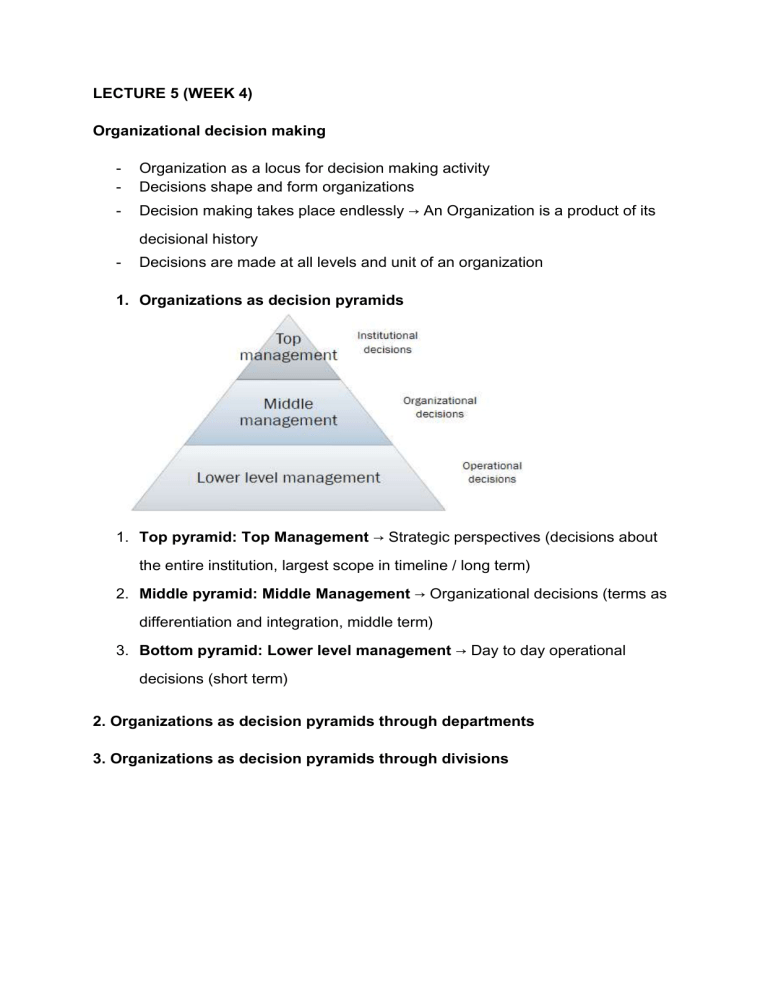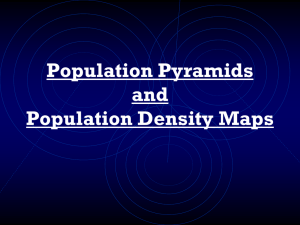
LECTURE 5 (WEEK 4) Organizational decision making - Organization as a locus for decision making activity Decisions shape and form organizations - Decision making takes place endlessly → An Organization is a product of its decisional history - Decisions are made at all levels and unit of an organization 1. Organizations as decision pyramids 1. Top pyramid: Top Management → Strategic perspectives (decisions about the entire institution, largest scope in timeline / long term) 2. Middle pyramid: Middle Management → Organizational decisions (terms as differentiation and integration, middle term) 3. Bottom pyramid: Lower level management → Day to day operational decisions (short term) 2. Organizations as decision pyramids through departments 3. Organizations as decision pyramids through divisions Rational Model of decision making (Hatch, M.J) 1. Define the problem → What problem are we going to solve 2. Generate and evaluate alternatives → What are the different ways or means to tackle the issue 3. Select an alternative → Where the actual decision takes place. 4. Implement the selected alternative 5. Monitor results → We see what happens and check if the initial problems are solved Normally it plays as a loop as once having monitored the results new problems appear or it still remains the same problem. Bounded Rationality Decisions are in practice often sub-optimal, due to: - Imperfect and incomplete information (data can be false) - Complexity of problems - Human information-processing capacity - Limited time for decision making - Conflicting preferences of DMs → Disagreements on what goals to achieve or how to achieve. Ambiguity: What are the problems we want to solve or goals we want to achieve. Uncertainty: What are the methods or knowledge we are going to bring to achieve or solve the problems. Decision-making process Rational model: - Agreement on goals or problem definition - Agreement on methods Trial-and-Error model: - Agrement on goals - Disagreement on methods - Often called incremental model, as you keep doing it over and over until you get it right. (Iterative) Coalitional model: - Disagreement on goals - Agreement on methods - Politics! - Form partnerships with people with similar interests. When interests differ so much, forming coalitions is the sensible thing to do. Garbage can model: - Disagreement on both goals and methods to use - Anarchic view of decision making Randomness of decision making Where problems, solutions, participants and choice opportunities are all independently flowing through the organization. → Many times universities as taken as an example of Garbage can model. Irrationality of organizational decision making (Brunsson, N.) ● Alternative: Focus more on actions instead of in decisions - Motivation Commitment Is much more about having motivation (desire to contribute) and commitment in what you are doing. ● Decision irrationality - Analyze few alternatives (preferably have just one good) → In order to make this sensible decision even more attractive - Consider only the positive, not negative → to create enthusiasm - Avoid formulating objectives in advance, instead reformulate the predicted consequences of the selected alternative as your decision making criteria Companies spend a lot of time making decisions when sometimes there is not that much time, therefore, decisions loss strength over the time and that is why it stresses actions rather than decisions. Capture latency: The time between the event occurs and having the data ready for the analysis. Analysis latency: The time between the you get the data ready for analysis and you deliver the information (analysis outcome) Decision latency: Before the action is taken, the time between you have all the information delivered and you make the decision. The role of (big) data - Many decisions based on (big) data grounded in through IS/DI Data driven decisio making Think about developments such as: - Big Data Algorithms (and AI) Blockchain

